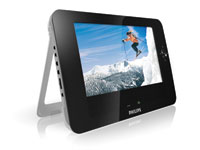Philips Electronics Revamps Distribution
 Customers of Philips Electronics set high, encompassing standards for delivery performance. The North American unit of Philips Electronics, a $2-billion division of Philips Global Electronics Company, sells Philips and Magnavox-branded traditional, projection and flat-screen TVs, DVD and video players, audio products and handheld devices.
Customers of Philips Electronics set high, encompassing standards for delivery performance. The North American unit of Philips Electronics, a $2-billion division of Philips Global Electronics Company, sells Philips and Magnavox-branded traditional, projection and flat-screen TVs, DVD and video players, audio products and handheld devices. Philips' outbound supply chain has a number of complex factors, including products with short life spans, and large and fragile products, like big-screen TVs. These factors were coupled with a mixture of in-house and outsourced distribution and transportation services that lend to logistics pain points, including:
> Unacceptable levels of inventory accuracy and control
> Out-of-date logistics systems
> Unclear responsibility and accountability across internal and external distribution and transportation functions
> Unacceptable service levels to customers that affected Philips' ability to maintain product placement with key consumer electronics retailers
> Lack of key performance metrics and lack of systems to enable those measurements
"The logistics/supply chain performance for our business had deteriorated to a point that it was affecting our ability to provide the level of service needed to our key customers and maintain appropriate control that met the requirements of a global business, like Philips Consumer Electronics," says Danny Garst, senior vice president of supply chain and IT, Nafta Region, Philips Consumer Electronics. "The company needed a total package solution from warehousing to transportation management to an end-to-end order management system that would allow the company to track its order through customer delivery. Given the competitiveness of the consumer electronics industry, we must constantly challenge, and in some cases, reinvent ourselves."
The Game Plan
In the fall of 2001, Philips sent out RFPs to third-party logistics providers. By assessing more than 25 areas of expertise, from IT systems to culture fit, Philips narrowed a pool of more than 20 possible providers down to just one - Ryder. Ryder became Philips' partner in late 2001 and conducted an assessment of Philips' network and material flows. It recommended that Philips close its distribution center (DC) in El Paso, Texas, and replace it with a new larger DC at Alliance Park near Dallas/Ft. Worth. Additionally, the Texas DC could serve as the U.S. receiving point for large-screen TVs built at Philips plant in Juarez, Mexico. Handling cross-border traffic is also part of the outsourcing contract. Philips followed the recommendation, built the new DC, developed and designed a new distribution system, deployed warehousing management and transportation management systems, and implemented outsourced operations all in a little more than eight months.
How it Works
Ryder's responsibility begins with electronic receipt of shipment delivery notes generated by Philips' SAP ERP system. These specify the delivery date that Philips promised based on inventory and production schedules. These delivery notes come into a Ryder proprietary order management system (ORD) designed by Ryder and located at Ryder's Transportation Management Center in Alliance Park. The order typically gives Ryder a 48-hour lead time, allowing time to collect orders and optimize them for the best load configuration and shipping method. Ryder uses a combination of in-house tools and optimization software from i2 Technologies for this purpose. After the optimization work has been completed, pick/pack and loading information is sent to the Manhattan Associate's PkMS warehouse management system at each of the DCs. As orders are being prepared in the warehouses, transportation specialists schedule appointments with carriers to pick up the shipments. Carriers then send EDI messages when an order has been delivered and that shipment confirmation is sent back to Philips' SAP system so customer service representatives know that the order has been closed out. The delivery confirmation is also used to measure whether Ryder is delivering on time or not. Throughout the process, Philips can track shipments through Ryder's online tracking system, RyderTrac. "All of the Ryder supply chain systems are integrated into our ERP SAP system, allowing proper internal controls, like inventory control, which allows customer service teams to track orders all the way through delivery," says Garst.
Delivering Results
Improved customer service and better inventory and cost control were the key deliverables that Philips sought when it outsourced finished goods distribution to Ryder in 2001.
"Over the five years of our relationship with Ryder, there have been continual improvements and there will continue to be for us to continue to be a leader in the consumer electronics world," says Garst.
Garst quantifies some benefits: "Before Ryder, our inventory accuracy was in the low 80 percent range and it was not being measured properly, but now that accuracy is at world-class levels," he says. "In addition, customer service levels that were previously unacceptable are now up 30 percent - levels that have allowed Philips to not only keep but increase its product placements, and in some cases, win 'Vendor of the Year' awards from the key consumer electronics retailers."

